Petrography at its most basic is akin to the “CSI of concrete”. At a more in depth level, Petrographers (those who study petrography) receive samples which they then cut, polish, and analyze at a microscopic level looking at aggregate, air, paste, cracking, and secondary deposits to determine what may cause a certain outcome in concrete. For this reason, petrography is a very useful tool in troubleshooting such things as concrete floors and floor covering de-bonding issues. Floor/flooring failures are often caused by moisture and water vapor transmission, but issues such as finishing, curing of the concrete substrate, the presence of deleterious materials and unexpected “bond breakers” all also play a significant role in floor/flooring failures. Field observation and traditional sampling is not always enough to successfully identify floor or flooring failures. A great many factors are only visible under significant magnification.
Petrographers are rarely part of a field survey and rely on the submitting forensic engineer or technician to provide a meaningful sample; one that is representative of the field conditions. An experienced petrographer can be an integral part of the problem identification, leading to solving the real problem. When evaluating flooring, the following may be key to unlocking where surfaces might go wrong. We begin by defining the standard petrographic practices, the finishing profile, curing, surface preparation, coatings, other cementitious materials, and the chemical properties of the material mix.
The standard of practice for petrography of concrete is ASTM C:856. ASTM C:1324 contains a section describing the petrographic analysis of hardened mortars; which can be likened to cementitious overlayments/underlayments or thin-sets. Experienced petrographers can easily identify the characteristics in hardened concrete affecting the success of the floor and/or flooring installation. The finishing profile, quality and duration of the curing process, and quality control of the various concrete-making constituents are all usually described by a petrographer. The w/cm (water cementitious ratio) may also be estimated. A high w/cm in the body of the concrete can induce excessive shrinkage cracking. A high w/cm at the top surface will produce a soft and friable substrate.
Finishing Profile
The finishing of a concrete slab can directly impact the need for or type of preparation required for a floor covering installation. An experienced petrographer can describe the type and duration of finishing the concrete surface has undergone. Prolonged troweling or “burning” the slab densifies the surface by removing water and creating an excessively low w/cm. Working rising bleedwater into the surface and not burnishing the water out can produce an excessively soft surface. This “premature” finishing coupled with carbon dioxide in the air produces the “dusting” phenomena commonly described as carbonation in concrete bulletins.
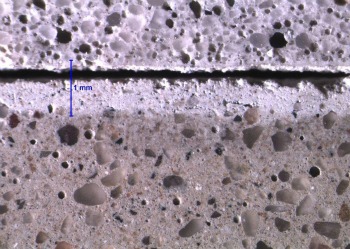 This condition is detrimental to the adherence of flooring adhesives, coatings, cementitious overlayments/underlayments or thin-sets (figure to the right). A finisher commonly struggles between leaving a softer, rougher finish for adhering flooring or producing a smooth, hard, dense surface by prolonged troweling. These “burnished” surfaces benefit from lightly sand or shot blasting the surface to increase bond surface area and can produce the best substrate for thin sets and adhesives. Unfortunately, burnished surfaces and low w/cm concretes are not quick to give up their moisture.
This condition is detrimental to the adherence of flooring adhesives, coatings, cementitious overlayments/underlayments or thin-sets (figure to the right). A finisher commonly struggles between leaving a softer, rougher finish for adhering flooring or producing a smooth, hard, dense surface by prolonged troweling. These “burnished” surfaces benefit from lightly sand or shot blasting the surface to increase bond surface area and can produce the best substrate for thin sets and adhesives. Unfortunately, burnished surfaces and low w/cm concretes are not quick to give up their moisture.
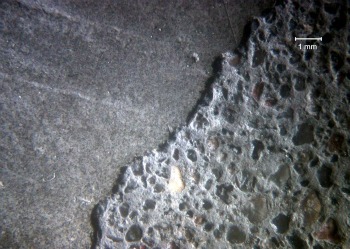 Deficiencies in power troweling procedures can produce anomalies which affect the quality of the final concrete surface. The redistribution of concrete paste late in the finishing procedure may result in thin delaminations that appear during grinding/polishing procedures (figure to the left) or shortly after the slab is put in service. This type of delamination differs from a more common phenomena that occurs upon planes of bleedwater trapped by delayed bleeding/premature finishing. Hardeners must be selected and tested carefully to avoid other issues such as alkali-silica reactivity (pop-outs).
Deficiencies in power troweling procedures can produce anomalies which affect the quality of the final concrete surface. The redistribution of concrete paste late in the finishing procedure may result in thin delaminations that appear during grinding/polishing procedures (figure to the left) or shortly after the slab is put in service. This type of delamination differs from a more common phenomena that occurs upon planes of bleedwater trapped by delayed bleeding/premature finishing. Hardeners must be selected and tested carefully to avoid other issues such as alkali-silica reactivity (pop-outs).
Curing
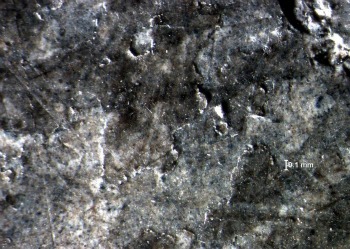
“Curing” refers to the act of keeping moisture in the concrete to further develop strength and durability by continuing portland cement hydration. Curing compounds utilized to combat early age drying must be removed before application of other cementitious materials, flooring adhesives, or coatings. Membrane forming curing compounds and sealers may act as “bond breakers”. Their presence is usually easy to recognize on the top surface of the concrete under magnification (figure to the right).
Surface Preparation
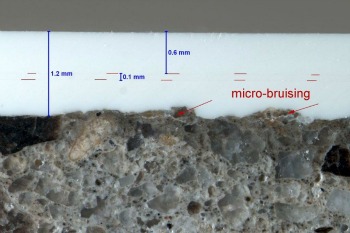 Surface preparation is an integral part of a successful floor covering installation. The preparation usually involves cleaning the surface of any potential organic bond breaker, removing any laitance or compromised concrete surface paste, and/or roughening the surface to provide more surface area for better mechanical bond. Standards for concrete surface profile (CSP) have been produce by the International Concrete Repair Institute (ICRI) in the form of molded rubber chips.
Surface preparation is an integral part of a successful floor covering installation. The preparation usually involves cleaning the surface of any potential organic bond breaker, removing any laitance or compromised concrete surface paste, and/or roughening the surface to provide more surface area for better mechanical bond. Standards for concrete surface profile (CSP) have been produce by the International Concrete Repair Institute (ICRI) in the form of molded rubber chips.
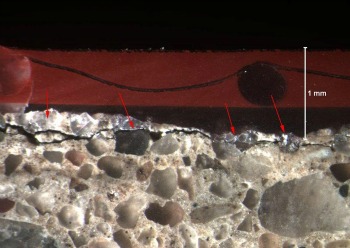 Surface preparation, when done, is obvious in the field, but not so obvious is the effectiveness. Petrographically prepared samples from concrete cores taken from representative locations can disclose “bruising;” a condition not discernable in the field. Aggressive impacting of the surface by scrabbling, (roto)-milling, or scarifying can damage the concrete at depth in the form of incipient spalls. Micro-bruising can also be detected (figure above, to the left)under microscopy of properly prepared core samples. Exposed and shattered quartz sand grains from shot blasting can detrimentally affect the bond of coatings (figure to the right).
Surface preparation, when done, is obvious in the field, but not so obvious is the effectiveness. Petrographically prepared samples from concrete cores taken from representative locations can disclose “bruising;” a condition not discernable in the field. Aggressive impacting of the surface by scrabbling, (roto)-milling, or scarifying can damage the concrete at depth in the form of incipient spalls. Micro-bruising can also be detected (figure above, to the left)under microscopy of properly prepared core samples. Exposed and shattered quartz sand grains from shot blasting can detrimentally affect the bond of coatings (figure to the right).
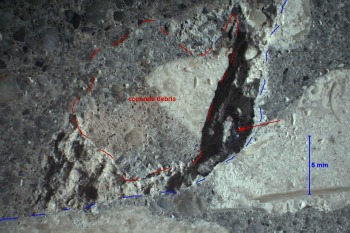 Surface cleanliness after floor slab preparation can also be assessed under a microscope. Deep recesses in the prepared surfaces can hold large amount of debris – especially high/ultra high pressure water jetted surfaces (figure to the left). Failed repairs and overlayments/underlayments often exhibit debris adhered to their undersides. This petrographer has found many materials other than concrete debris at failed contacts: including steel shot, steel shavings, and sawdust. Protrusions in vinyl sheet goods or vinyl composite tile (VCT) have commonly been identified as construction debris and splatters of spackle or mortars.
Surface cleanliness after floor slab preparation can also be assessed under a microscope. Deep recesses in the prepared surfaces can hold large amount of debris – especially high/ultra high pressure water jetted surfaces (figure to the left). Failed repairs and overlayments/underlayments often exhibit debris adhered to their undersides. This petrographer has found many materials other than concrete debris at failed contacts: including steel shot, steel shavings, and sawdust. Protrusions in vinyl sheet goods or vinyl composite tile (VCT) have commonly been identified as construction debris and splatters of spackle or mortars.
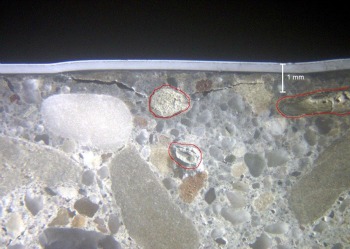 However, in certain geographical locations, especially in some parts of the Midwest, alkali-silica reactive (ASR) coarse and fine aggregate particles in the concrete expand beneath moisture sensitive coatings and flooring (figure to the right). These impervious coverings trap moisture and concentrate “alkalis” – providing a perfect environment for these expansive reactions. Alkalis can also have a negative affect on adhesives used to bond the flooring material to the concrete substrate.
However, in certain geographical locations, especially in some parts of the Midwest, alkali-silica reactive (ASR) coarse and fine aggregate particles in the concrete expand beneath moisture sensitive coatings and flooring (figure to the right). These impervious coverings trap moisture and concentrate “alkalis” – providing a perfect environment for these expansive reactions. Alkalis can also have a negative affect on adhesives used to bond the flooring material to the concrete substrate.
Coatings
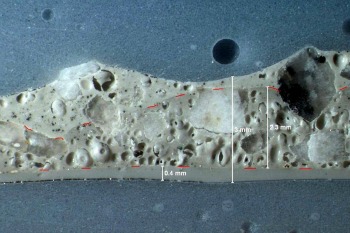 Often, coatings are comprised of a primer, a base coat, and a finish coat. Commonly, an inorganic filler or friction media will be broadcast into the surface. These materials are usually comprised of natural or manufactured sands, or industrial minerals such as silica carbide. Elastic traffic membranes can also be studied, but usually require some type of mounting and stabilization in another polymer (figure to the left).
Often, coatings are comprised of a primer, a base coat, and a finish coat. Commonly, an inorganic filler or friction media will be broadcast into the surface. These materials are usually comprised of natural or manufactured sands, or industrial minerals such as silica carbide. Elastic traffic membranes can also be studied, but usually require some type of mounting and stabilization in another polymer (figure to the left).
Other Cementitious Materials
Cementitious underlayments, overlayments, setting beds, and thin-sets can be reverse-engineered through transmitted light microscopy on thin sections produced from these materials. Common components are a natural or manufactured fine aggregate or sand, with a binder comprised chiefly of portland cement often blended with carbonate or silica flour, hydrated lime, flyash, or slag cement. These materials are generally highly sensitive to water content during mixing. Excessive segregation of fine aggregate and the presence of laitance or worked-in bleedwater are commonly identified deficiencies in their placement.
Chemical Profile
Finally, you may need to consider the chemical profile of the flooring mix. Generally, integral organic materials are not obvious under optical microscopy. Ancillary analysis by Fourier-transform infrared spectroscopy (FTIR) can identify any organic modification of the cementitious binder. Further, FTIR can identify the composition of coatings, adhesives, and bonding agents. FTIR has been successful in revealing penetrative organic bond breakers not visible under optical microscopy. Examples of these materials include: light oils, kerosene, and form release agents.
All of these pieces of the petrographic puzzle will help understand the quality of the flooring and why it is behaving the way it is. You might need all of them to understand the failure in front of you but all studies are available to help figure out what isn’t obvious to the naked eye.
For more information on our petrographic analysis services, please visit our Petrography service page.

